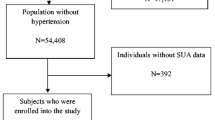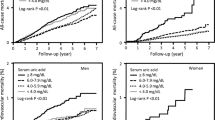Abstract
A number of cross-sectional analysis studies have been conducted to determine the relationships between serum uric acid and related variables or clinical manifestations. However, few data related to changes in serum uric acid within the same cohort population at two separate periods of time have been reported. In this study, we investigated the changes in serum uric acid in a population from baseline to 1-year follow-up and examined the associations with related parameters and medical conditions. A total of 1,437 eligible male subjects who underwent 2 medical examinations at a health promotion center at an interval of approximately 12 months were enrolled in this study. Data were obtained from routine physical assessments such as blood pressure, height, waist circumference, blood analyses for liver function, renal function, lipid profile, and electrolytes, along with standardized questionnaires including self-reported data. In this population, serum uric acid was significantly increased at 1-year follow-up compared with the baseline level (5.94 ± 1.20 vs 5.99 ± 1.22, p = 0.003). Changes of some confounders such as total bilirubin, creatinine, BUN, phosphorus, total cholesterol, and triglyceride were significantly associated with changes in serum uric acid. Among them, serum creatinine may be the most influential in determining the serum uric acid level (odds ratio = 21.691, 95%CI = 5.110–92.086). A change of serum uric acid over 1 year did not seem to affect changes in the clinical status for some medical conditions including hypertension, diabetes mellitus, cardiovascular disease, and metabolic syndrome. This analysis showed that a change in serum creatinine level between baseline and 1-year follow-up might be the most potent factor affecting a change in serum uric acid in healthy, male subjects. Changes of serum uric acid did not show any meaningful impact on the development of hypertension, heart failure, diabetes mellitus, and metabolic syndrome in this 1-year follow-up study.
Similar content being viewed by others
References
Ghei M, Mihailescu M, Levinson D (2002) Pathogenesis of hyperuricemia: recent advances. Curr Rheumatol Rep 4:270–274
Sica DA, Schoolwerth AC (2002) Part 1. Uric acid and losartan. Curr Opin Nephrol Hypertens 11:475–482
Enomoto A, Kimura H, Chairoungdua A et al (2002) Molecular identification of a renal urate anion exchanger that regulates blood urate levels. Nature 417:447–452
Shima Y, Teruya K, Ohta H (2006) Association between intronic SNP in urate-anion exchanger gene, SLC22A12, and serum uric acid levels in Japanese. Life Sci 79:2234–2237
Nan H, Qiao Q, Dong Y et al (2006) The prevalence of hyperuricemia in a population of the coastal city of Qingdao, China. J Rheumatol 33:1346–1350
Lohsoonthorn V, Dhanamun B, Williams MA (2006) Prevalence of hyperuricemia and its relationship with metabolic syndrome in Thai adults receiving annual health exams. Arch Med Res 37:883–889
Kim EH, Jeon K, Park KW et al (2004) The prevalence of gout among hyperuricemic population. J Korean Rheum Assoc 11:7–13
Rott KT, Agudelo CA (2003) Gout. JAMA 289:2857–2860
Rho YH, Choi SJ, Lee YH et al (2005) The prevalence of metabolic syndrome in patients with gout: a multicenter study. J Korean Med Sci 20:1029–1033
Mellen PB, Bleyer AJ, Erlinger TP et al (2006) Serum uric acid predicts incident hypertension in a biethnic cohort: the atherosclerosis risk in communities study. Hypertension 48:1037–1042
Conen D, Wietlisbach V, Bovet P et al (2004) Prevalence of hyperuricemia and relation of serum uric acid with cardiovascular risk factors in a developing country. BMC Public Health 4:9
Lin KC, Tsao HM, Chen CH et al (2004) Hypertension was the major risk factor leading to development of cardiovascular diseases among men with hyperuricemia. J Rheumatol 31:1152–1158
Culleton BF, Larson MG, Kannel WB et al (1999) Serum uric acid and risk for cardiovascular disease and death: the Framingham Heart Study. Ann Intern Med 131:7–13
Nakanishi N, Suzuki K, Kawashimo H et al (1999) Serum uric acid: correlation with biological, clinical and behavioral factors in Japanese men. J Epidemiol 9:99–106
Munan L, Kelly A, Petitclerc C (1976) Population serum urate levels and their correlates. The Sherbrooke regional study. Am J Epidemiol 103:369–382
Fang J, Alderman MH (2000) Serum uric acid and cardiovascular mortality the NHANES I epidemiologic follow-up study, 1971–1992. National Health and Nutrition Examination Survey. JAMA 283:2404–2410
Anonymous (1999) 1999 World Health Organization–International Society of Hypertension Guidelines for the Management of Hypertension. Guidelines Subcommittee. J Hypertens 17:151–183
Anonymous (1997) Report of the Expert Committee on the diagnosis and classification of diabetes mellitus. Diabetes Care 20:1183–1197
Eckel RH, Grundy SM, Zimmet PZ (2005) The metabolic syndrome. Lancet 365:1415–1428
Expert Panel on Detection, Evaluation, and Treatment of High Blood Cholesterol in Adults (2001) Executive Summary of the Third Report of The National Cholesterol Education Program (NCEP) Expert Panel on Detection, Evaluation, and Treatment of High Blood Cholesterol in Adults (Adult Treatment Panel III). JAMA 285:2486–2497
World Health Organisation Western Pacific Region (2000) The Asia-Pacific perspective: redefining obesity and its treatment. Co-sponsored by the Regional Office for the Western Pacific, World Health Organization, International Association for the Study of Obesity and the International Obesity Task Force
Baillie JK, Bates MG, Thompson AA et al (2007) Endogenous urate production augments plasma antioxidant capacity in healthy lowland subjects exposed to high altitude. Chest 131:1473–1478
Lin JD, Chiou WK, Chang HY et al (2007) Serum uric acid and leptin levels in metabolic syndrome: a quandary over the role of uric acid. Metabolism 56:751–756
Rathmann W, Haastert B, Icks A et al (2007) Ten-year change in serum uric acid and its relation to changes in other metabolic risk factors in young black and white adults: the CARDIA study. Eur J Epidemiol 22(7):439–445. DOI 10.1007/s10654-007-9132-3
Perez-Ruiz F, Calabozo M, Herrero-Beites AM et al (2000) Improvement of renal function in patients with chronic gout after proper control of hyperuricemia and gouty bouts. Nephron 86:287–291
Darmawan J, Rasker JJ, Nuralim H (2003) The effect of control and self-medication of chronic gout in a developing country. Outcome after 10 years. J Rheumatol 30:2437–2443
Bairaktari E, Liamis G, Tsolas O et al (2001) Partially reversible renal tubular damage in patients with obstructive jaundice. Hepatology 33:1365–1369
Mielants H, Veys EM, de Weerdt A (1973) Gout and its relation to lipid metabolism. II. Correlations between uric acid, lipid, and lipoprotein levels in gout. Ann Rheum Dis 32:506–509
Shankar A, Klein R, Klein BE et al (2006) The association between serum uric acid level and long-term incidence of hypertension: population-based cohort study. J Hum Hypertens 20:937–945
Perlstein TS, Gumieniak O, Williams GH et al (2006) Uric acid and the development of hypertension: the normative aging study. Hypertension 48:1031–1036
Author information
Authors and Affiliations
Corresponding author
Rights and permissions
About this article
Cite this article
Choe, JY., Park, SH., Kim, JY. et al. Change in serum uric acid between baseline and 1-year follow-up and its associated factors in male subjects. Clin Rheumatol 27, 483–489 (2008). https://doi.org/10.1007/s10067-007-0732-9
Received:
Revised:
Accepted:
Published:
Issue Date:
DOI: https://doi.org/10.1007/s10067-007-0732-9




